Just So Happens
By Fumio Obata
Published by Jonathan Cape
Buy This Book
Upon first impression of Fumio Obata’s new graphic novel, Just So Happens, I was struck with a lot of similar impressions that arose whilst reading a related, albeit a hastily associated work, Glyn Dillon’s Nao of Brown. Sure, both recount stories about a Japanese woman who now call London home and likewise are authored by men who have a history of working in animation, but these correlations are as redundant as clumping their narratives into the category of ‘graphic novels’, or even as mere examples of international comics. Where Just So Happens splits from its resemblance to The Nao of Brown is in how it emerges as an end product that investigates cultural identity within globalization in a way that fruitfully hones its roots in not only Japan but also as largely influenced by European visual history. Yumiko takes the lead in the story and upon returning home for her father’s abrupt funeral, finds herself immersed in a confrontation of personal cultural difference, manifesting in reality as well as in the mystic esthetics of Noh theatre. Just So Happens is a unique graphic undertaking in the concept of transcultural works. Obata visually and thematically blends Japanese and European visual culture to compose a tale that is dynamic in its hybridity, and thereby conceives a poignant graphic narrative that exposes cultural identity as a process of constant change.Obata’s style has appropriately been described as a melting pot of manga elements and the ligne-claire method characteristic of Bande Dessinee cartoonists. This designation rings true in regards to the luminous, illustrative skill that Obata delivers in the pages of Just So Happens. Page after page is remarkably filled with expressive simplicity and detail in his characters, consistently matched with that of his backgrounds. Obata’s equal attention to every element of the page’s content is wholly evident—it’s often the intricate, surreal landscapes of Japanese mountains that are the most captivating in their delicacy. Even the mishmash of his characters’ soft outline uniformity with the rich washes in their backdrop work synchronously in creating scenes that induce a dreamlike, Murakami-esque imagery, regardless of whether the portrayed place is in Japan, London, or the in-between fantasy world in Yumiko’s mind. Obata’s aesthetic influence is seemingly more grounded in the craft of Franco-Belgian comics, and while it permeates throughout the work, it is Obata’s subtle, figurative infusion of classical Noh theater that creates an interplay amidst these two styles, splicing together the nostalgic and historical implications of these nation-specific art forms.
From the get go, Yumiko’s struggle to negotiate her Japanese heritage and current British inhabitancy is an almost too recognizable conflict—the works of Gene Yang and Adrian Tomine have similarly delved into examining inner struggles of cosmopolitan identity. Yuminko doesn’t stand out right away as an exceptional character to express this dilemma. At first, she represents a hodgepodge of the stereotypes of assimilation: the icy, emotionally-guarded Japanese woman dating a British man, repelled at the sight of other Japanese people passing by. The adamant rejection of her culture is clear to almost everyone but herself. What drew me in to Obata’s handling of Yumiko’s character was how he addressed her national dismissal without being too overtly affectional. Yumiko’s subconcious friction unravels within her mind, enacted by a mirror of her stoic psyche, the stone-faced Noh performer.
Yumiko’s first interaction with Noh theater is captured in a flashback as she comes across a performance during a summer stroll. The Noh performer thus becomes a reoccurring phantom and is rendered in some of the book’s lushest brushstrokes, its enduring image absorbs Yumiko’s subconscious along with the pages it penetrates. The Noh performer and Obata’s adaptation of its dramatic makeup is saturated in the core of Just So Happens, revealing the work as a versed reinterpretation of both Japanese and European imagery. Obata’s choice coloring echoes the naturalistic pigments of Noh masks, hence capturing the distinctive Noh quality of the profound beauty that exists in the transcendental world, including the mournful elegance involved in the sadness over death. Yumiko’s own detached remorse is reflected in her disorientation with the ambiguous effect of the Noh mask, and as the story carries on, she discovers the expressionless face is not based in a cold indifference, instead the mask embodies a paradox of concealment and revelation. The Noh theater is traditionally based in the stage as a complex metaphysical realm, where the spectators and actors create meaning through joint effort. Yumiko ultimately appeases her inner-torment by surpassing her inactive role as bystander, in both Japan and London, by willingly engaging a fundamental aesthetic rule of Noh, the hana (flower), in which a perfect balance of performance and reception is achieved.
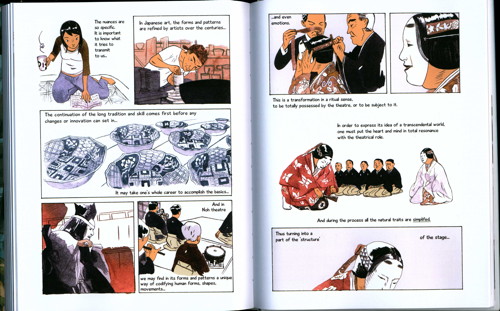
The turning point of the book is Yumiko’s crucial confrontation with the Noh specter, as she enters the spirit world that Noh is aimed to represent. It is here she settles the inner crisis of her own private struggle, unmasking the cultural chaos latent within, in an operatic climax as the pavilion’s pillars crumbles away. This controlled frenzy is rendered spectacularly, equivalently simulating a visualization of the space in Noh drama. The panels where Yumiko envisions this imaginary space are the most spectacular twinkles in the otherwise calm color washes, notably the flaming, bold use of reds, blacks, and white when Yumiko finally lets emotion pierce her disconnected psyche.
Where Just So Happens falters as a whole is the ellipses-heavy, facile text. My main complaint is the choice in font—the chunky lettering clashes compared to his gesturely brushwork style, and I wish he didn’t fill so many balloons with onomatopoeia since there are some points where he colors in sound effects to create their own background of flying letters and marks. Without diving too deep into the long-debated argument over whether or not the text and image need to work congruously in order to be an effective piece, I solidly accept the weakness of Obata’s dialogue alongside the splendor in his art. I don’t believe Obata intended the story to be taken too seriously, and if anything the simplistic, conversational dialogue is interspersed nicely within his larger panels, allowing the flowing nature of his art to slow down the reader’s eye, to take in his backgrounds in a contemplative course of time.
Set for release stateside later this month by Jonathan Cape with a French translation coming in April, Just So Happens is a memorable addition the growing indie graphic novel body. Fumio Obata accomplishes a compelling graphic narrative that rebuffs the unsatisfactory national/international binary that classifies comics as belonging to a single visual framework, demonstrating the rich and diverse international heritage emerging from unrecognized creators. The incorporation of the strong bandes desinees visual style and the Noh theater aesthetics is an understated and intelligent choice for choreographing a vibrant display of emotional composition. The graphic novel’s simplistic narrative is the backbone to the engrossingly dreamy landscapes and Obata swings the pendulum from reality to dream masterfully, allowing his stylistic magic to spew from the page.
For more information on Fumio Obata and Just So Happens, check out his charismatic and engaging blog.


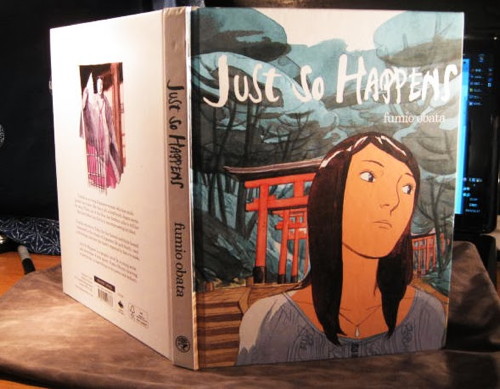

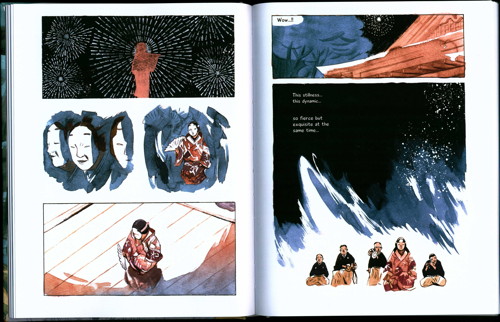
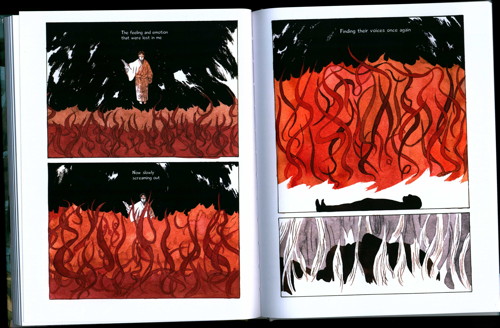
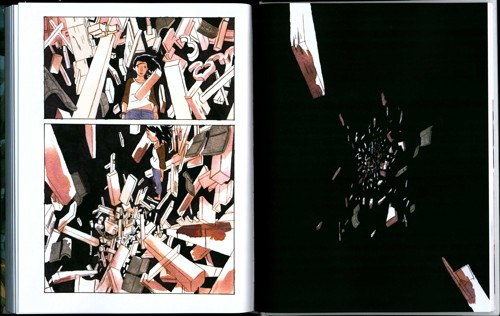






Looks wonderful and thanks for bringing this to our attention.
My only quibble is that the images are quite small — so I can’t see the problem with the font as Jessica notes. But I understand that’s often out of control of the reviewer.
Those pages are stunning
Comments are closed.